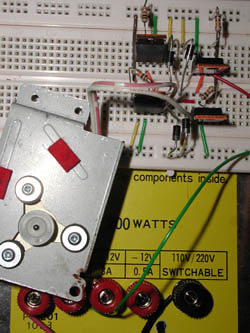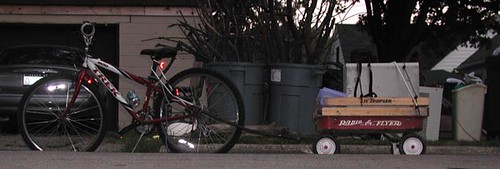Introducing...The H-Bridge!
At this point, our first robot has motors to drive the wheels, a spiffy frame, and nothing else. We're going to need a way to distribute power to the drive wheels, under the control of the processor. The first step in this is to create an H-bridge. An H-bridge is a circuit that allows one to send power to a device forwards and backwards. In fact, an H-bridge has four operating modes: coast, forward, backward, and brake. I could try to explain the H-bridge, but other sites, such as http://www.robotroom.com/HBridge.html, do a fine job, so I'll leave it to them.
 Here's our H-Bridge. It is based on the International Rectifier RFZ44N power MOSFET. Playing with these MOSFETs taught me something interesting. Unlike a "traditional" transistor, which is current-based, MOSFETs are voltage-based. When you supply a voltage to the gate of a MOSFET and then disconnect it, the gate remains energized and power keeps flowing from source to drain. So in my H-bridge are four pull-down resistors to force the signal low when power is not being applied. Also note the diodes to keep the motor from pumping current where it doesn't belong. We chose the MOSFET because it is the same one used by the manufacturer of the cordless drills, so we know they can handle the current. The one issue is that the RFZ44N requires more than 5V to close, so we'll need to use another transistor to switch on the RFZ44N.
Here's our H-Bridge. It is based on the International Rectifier RFZ44N power MOSFET. Playing with these MOSFETs taught me something interesting. Unlike a "traditional" transistor, which is current-based, MOSFETs are voltage-based. When you supply a voltage to the gate of a MOSFET and then disconnect it, the gate remains energized and power keeps flowing from source to drain. So in my H-bridge are four pull-down resistors to force the signal low when power is not being applied. Also note the diodes to keep the motor from pumping current where it doesn't belong. We chose the MOSFET because it is the same one used by the manufacturer of the cordless drills, so we know they can handle the current. The one issue is that the RFZ44N requires more than 5V to close, so we'll need to use another transistor to switch on the RFZ44N.

